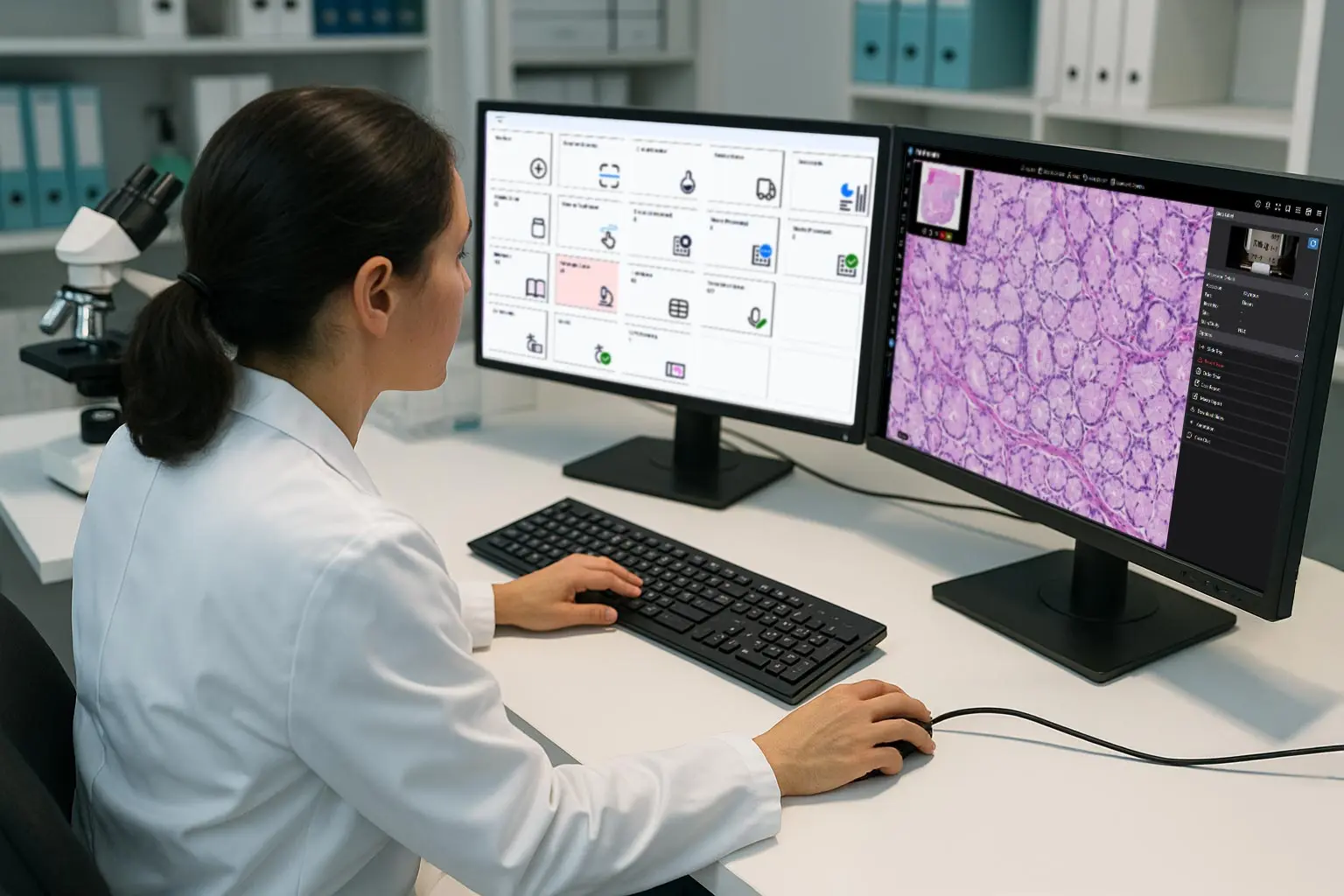Blog
Top 10 Medical Laboratory Mistakes and How to Prevent Them from Happening in Your Lab
June 16, 2025
The phrase “Mistakes happen” is often used casually in the U.S., but in healthcare, especially within the medical laboratory, even small errors can have serious consequences. In this setting, every detail matters because patient health is directly affected.
Diagnostic Errors and Preventable Deaths
Before listing the most common mistakes found in a medical lab, it’s first important to get a sense of scale.
It’s estimated that medical error is the third most common cause of death in the U.S., with diagnostic errors accounting for 25 percent of those deaths. However, just how many deaths occur each year due to medical error remains an open debate, as estimates range from 160,000 to 400,000, depending on which published report you reference.
A report published by the National Institutes of Health, The Measurement of Errors in Clinical Laboratories, offers a closer look at the numbers. It found that 80 to 90 percent of all medical diagnoses rely on laboratory test results, with diagnostic errors occurring in approximately 0.012% to 0.6% of all tests.
Now measure that error rate against the estimated 7 billion clinical lab tests performed in the U.S. each year, and it’s clear that thousands of preventable deaths are occurring annually due to diagnostic error.
The report also noted what we already know full well, that the diagnostic testing process is very complex. It involves various procedures, equipment, technology, and human expertise, and all of these elements must come together seamlessly to ensure accurate, precise, and timely diagnosis and treatment decisions.
Learn More: How Best Practices and Advanced Laboratory Information System Technology Help Ensure Lab Workflow Management
More Variables to Consider
Now that we’ve established that mistakes happen in the laboratory, let’s cover a few other variables. The frequency and types of errors can vary widely depending on several factors: the expertise of the clinical lab or pathology group’s personnel, the complexity of the tests performed, the effectiveness of laboratory information systems (LIS systems), and the quality control measures deployed by the lab.
White Paper: What You Need to Know Before Contracting with a Laboratory Information System Company
It’s also important to note that the medical field is heavily regulated. Clinical laboratories and pathology groups must comply with strict standards set by organizations such as the College of American Pathologists (CAP), the Clinical Laboratory Improvement Amendments (CLIA), and the Health Insurance Portability and Accountability Act (HIPAA). When mistakes do occur—as they sometimes will—they’re subject to thorough investigation to strengthen lab processes and prevent future incidents.
On-Demand Webinar: Has Our Laboratory Outgrown Its Laboratory Information System?

Common and Preventable Laboratory Mistakes
Thanks to high levels of complexity and massive volume, some medical laboratory mistakes are inevitable. However, just as testing volumes continue to grow annually, one can argue that the technology and innovation present within advanced pathology lab software and modern laboratory information systems - the informatics workhorses that support advanced laboratory workflow management - are keeping pace by providing LIS pathology solutions that not only flag diagnostic errors but also help prevent them from happening in the first place.
Here’s a list of common and preventable lab errors that can happen when clinical labs and pathology groups fail to put a premium on the best laboratory information system software that excels in efficiency and compliance.
Case Study: A Conversation With LIS System Administrator Kristie Becerra
Data Entry Errors
Ideally, medical labs would utilize modern laboratory information systems (medical LIS software) that digitally accept requisitions into the lab, but some labs still rely on manual transcriptions of test orders. This creates an opening for human error in the preanalytical stage.
Prevention Strategies for Data Entry Errors
- Implement internal systems that require double entry of critical data (entered twice and cross-checked for inconsistencies).
- Have another team member independently verify data entries.
- Integrate pathology lab software that can assist by automatically flagging potential errors before they go downstream.
- Periodically perform random audits of the department to identify workflow gaps and correct errors.
- Utilize input masking for data validation. An input mask is a string of characters that indicates the format of valid input values (examples: telephone numbers, zip codes, dates, and times).
- Incorporate a user-friendly order entry interface that intuitively simplifies data entry tasks (example: order entry interface drop-down menus).
Patient Identification Errors
Mistakes in patient identification can have severe consequences by causing specimens to be misattributed or mixed up. Providing that each specimen must not only be correctly linked to a patient but also tracked through various stages of processing and testing, ensuring accurate identification is critical. A single error in this chain can result in misdiagnosis, incorrect treatment, and worse, harm to the patient.
Prevention Strategies for Patient Identification Errors
- Assign a unique ID to every specimen and each specimen derivative (like tissue slides or paraffin blocks). This prevents mix-ups and ensures that each unique ID can be traced back to the original specimen and case.
- Implement a coding system that uses specific colors to differentiate between specimen types and urgency levels.
- Utilize a two-point verification protocol requiring staff to verify patient data with two distinct data points (examples: name and date of birth).
- Implement a robust and automated sample tracking system to follow each specimen (and its derivatives) through every processing stage.
- Utilize lab pathology software that triggers alerts when discrepancies or mismatches in patient data and specimen IDs are discovered.
- Conduct random audits and quality checks to make sure sample tracking protocols are being followed.
- Establish Standard Operating Procedures (SOPs) that clearly outline the specimen handling and identification processes.
- Develop a positive work environment that encourages the reporting of all mistakes and treats miscues or near misses as a learning opportunity.
- Encourage regular communication and feedback loops within the team to share knowledge and improvements.
Learn More: How Specimen Tracking Software Improves Efficiency and Reduces the Chance for Diagnostic Errors
Mislabeling
This simple and preventable mistake at the preanalytical stage can lead to delayed treatment and dire consequences. Like data transcription errors, mislabeling can be prevented by using a medical laboratory information system that supports barcode labels and assigns unique IDs for every specimen.
Prevention Strategies for Mislabeling
- Utilize an advanced laboratory information system LIS software to track specimens throughout their testing journey.
- Implement a barcoding system for both specimen containers and patient information.
- Establish a simple and standardized labeling procedure that’s easy for staff members to follow.
- Make comprehensive and ongoing staff training a priority so the entire team is highly proficient and well-prepared to minimize errors.
- Implement a two-person verification system (for example, one person collects the specimen and another verifies the labeling information before processing moves forward).
- Introduce a checklist as part of the clinical lab workflow to ensure that all necessary steps in specimen collection and labeling are completed before moving on to the next stage.
- Encourage open communication among team members so all staff members feel comfortable reporting potential errors or concerns without hesitation.
- Employ an adequate number of trained staff members (especially during peak hours) to handle the workload and minimize stress.
- Conduct a thorough investigation to identify the root cause whenever a mislabeling incident occurs.
- Develop a culture of continuous improvement and use feedback from mislabeling incidents to update and strengthen prevention protocols.
Learn More: The Role of Anatomic Pathology LIS Software in Optimizing Laboratory Workflow Management

Specimen Swapping
This is similar to mislabeling in that it’s preventable with the right pathology lab management system. Modern LIS lab systems support error-free specimen handling and the secure tracking of specimens from receipt through the recording of test results, preventing the unintentional swapping of samples or test results during processing.
Prevention Strategies for Specimen Swapping
- Use at least two unique patient identifiers (examples include name, date of birth, and medical record number) to verify the patient’s identity at every step of the testing process.
- Implement barcode or radio-frequency identification scanning (RFID) at multiple points in the testing workflow to ensure that the specimen and patient information match.
- Separate the collection area for a particular test or department from others to prevent the mixing up of specimens.
- Use tamper-evident seals on specimen containers and conduct routine inspections to confirm they remain secure and untouched.
- Conduct regular training sessions that reinforce proper specimen identification techniques.
- Establish clear and open communication channels between specimen collection points and the lab.
- Install surveillance cameras in specimen storage and processing areas to monitor staff activity and identify irregular actions.
Contamination
Any deviation from a clinical lab workflow or proper hygiene can introduce dangerous contaminants that put test results into question. High-volume labs that rely on batch testing of specimens are most at risk, as are labs that aren’t properly trained. Regular quality control (QC) checks and ongoing prevention protocols can help protect the lab from contamination.
Prevention Strategies for Contamination
- Ensure all staff members use proper hygiene, wear appropriate personal protective equipment (PPE), and regularly disinfect work surfaces.
- Avoid potential cross-contamination by restricting the movement of contaminated materials or equipment into designated clean areas.
- Regularly monitor and maintain good air quality to guard against dust, particles, or other potential contaminants.
- Establish a stringent cleaning and disinfection schedule for all lab surfaces, instruments, and other tools within the laboratory.
- Implement strictly followed protocols for the disposal of hazardous waste and contaminated materials.
- Perform regular maintenance and calibration checks on all lab instruments to ensure they function correctly and don’t contaminate specimens.
- Keep records that detail all procedures, including specimen handling and instrument maintenance.
- Conduct regular health checks for all lab personnel to identify and mitigate any potential sources of contamination (examples: infections or illnesses).
- Develop and communicate clearly understood protocols and conduct regular drills that reinforce how to respond to spills, accidents, or other urgent issues that could lead to contamination.
Learn More: A Detailed Look at How Modern Laboratory Information Systems Fully Support Quality Control
Expired Reagents
Reagents have a limited shelf life because their chemical properties change over time. Therefore, the use of expired reagents can adversely affect diagnostic test results. To avoid this mistake, labs must follow the manufacturer's guidelines regarding reagent storage and expiration dates.
Prevention Strategies for Expired Reagents
- Regularly update and review the lab’s inventory records to identify and remove all expired reagents from the stock.
- Clearly label all reagents with their expiration dates visible and easily accessible.
- Train lab staff to always use reagents from the back of the room or shelf, ensuring older stock is always pulled and utilized first.
- Establish regular communications with the lab’s reagent suppliers to receive notifications about upcoming expirations.
- Add pathology lab reporting software built to track reagent expiration dates and issue alerts when it’s time to order more reagents.
- Conduct regular audits to identify expired items.
- Maintain detailed records and documentation of all purchased reagents, their usage, and expiration dates.
- Appoint specific personnel to monitor expiration dates and oversee timely reagent replacements.
Learn More: Pathology Lab Management 2025 Guide - Best Laboratory Information System Software and Practices

Improper Storage
Every sample has specific storage requirements. Failure to adhere to the requirements put forth by regulatory bodies can lead to a change in a sample’s composition and distorted test results. To prevent this, lab directors and managers should build regular monitoring and quality checks into all storage protocols.
Prevention Strategies for Improper Storage
- Label all storage shelves, cabinets, and refrigerators to indicate what items should be stored in each area.
- Regularly monitor and record temperatures in storage areas to ensure quality.
- Use humidity control systems if necessary to prevent moisture-related damage.
- Maintain good ventilation in storage areas to prevent any buildup of odors or fumes.
- Store all chemicals and hazardous materials in support of regulations and safety guidelines.
- Schedule regular inspections of storage areas to detect any signs of leaks or contamination.
- Be sure to separate all incompatible materials to prevent hazards such as accidental reactions.
- Use security cameras and alarms to prevent unauthorized access and potential tampering.
- Ensure all specimens and reagents are securely packaged and properly sealed in storage.
- Develop and communicate protocols to handle spills, leaks, or other emergencies in storage areas.
- Maintain accurate records of storage conditions, inventory, and inspections.
Improper Instrument Calibration
Laboratory instruments must be calibrated regularly to ensure readings are accurate and reliable. Proper documentation of these calibration checks by qualified personnel helps ensure that the diagnostic results can be trusted.
Prevention Strategies for Improper Instrument Calibration
- Establish a routine calibration schedule for all laboratory instruments, following both manufacturer guidelines and applicable regulatory standards.
- Develop and communicate standard operating procedures for instrument calibration, outlining all steps and procedures.
- Assign calibration as a regular task for qualified technicians and administer resources to stay current on the latest techniques and technologies.
- Regularly verify the accuracy of certified reference materials (CRMs) to ensure the reliability of all calibration processes.
- Maintain certificates of calibration for reference and to demonstrate lab-wide transparency.
- Implement routine QC checks using all known standards and controls to verify accuracy.
- Consider investing in an automated calibration system that can standardize the process (and reduce potential human error).
- Keep a logbook near each instrument that indicates its calibration status and any upcoming calibration schedule.
- Address any suspected malfunctions and irregular readings promptly to maintain instrument performance.
- Use business management software to schedule and track all calibration activities.
Learn More: Pathology Lab Reporting Software - Enhancing Laboratory Efficiency
Neglecting Quality Control
Medical laboratories perform routine checks to detect and correct errors in the analytical process. By continuously analyzing quality control data, labs can identify patterns and emerging trends, helping to ensure the accuracy and reliability of test results.
Prevention Strategies for Neglecting Quality Control
- Assign a quality manager to oversee and enforce all quality control processes within the lab.
- Provide ongoing training and educational programs for lab personnel, emphasizing the critical role of quality control in daily operations.
- Develop clear and straightforward procedures that detail all processes.
- Maintain accurate records of all activities.
- Participate in external testing programs to compare your lab’s proficiency and performance against other labs.
- Implement internal procedures (such as running regular control samples) to monitor the accuracy of the lab’s analytical processes.
- Perform a thorough investigation of QC failures or variances from the expected analytical results.
- Conduct maintenance and calibration checks on all lab instrumentation.
- Encourage all staff members to report any concerns related to quality control immediately.
Learn More: Manage Complex Processes and Streamline Operations with LigoLab's Clinical Laboratory Solutions
Inadequate Training
The importance of specialized training of lab personnel cannot be overstated. Highly trained staff can implement procedures correctly and maintain quality. A lack of proper training can expose the lab to reliability and efficiency issues that may directly impact patient safety.
Prevention Strategies for Inadequate Training
- Develop structured and comprehensive training programs for all lab personnel that cover standard operating procedures, safety protocols, and instrument operation.
- Provide enhanced training modules tailored to specific roles and responsibilities within the lab.
- Pair new hires with experienced staff who can provide guidance and mentorship, answer questions, and teach proper techniques.
- Support staff members with resources for attending workshops, conferences, and other training opportunities with the latest techniques and technologies.
- Regularly conduct skills assessments and evaluate competency levels for all lab personnel.
- Introduce and utilize interactive training techniques such as simulations and group discussions to reinforce continuous staff improvement.
- Rotate staff members through different departments to cross-train and broaden their knowledge base and expertise.
- Periodically review all training records to ensure staff compliance and identify staff members who may require additional training.
- Build a supportive environment where staff members are encouraged to seek help and ask questions.

How Advanced Laboratory Information Systems Improve Efficiency and Patient Safety
Advanced laboratory information systems like the all-in-one LigoLab Medical LIS & Lab Billing Informatics Platform expertly manage all lab information (patient and specimen data, plus test results). They also automate or simplify complex lab processes (like sample management, quality control, and compliance) that would otherwise leave the organization vulnerable to diagnostic errors that put test results into question.
Moreover, the LigoLab platform uniquely offers a single, embedded suite of LIS system applications designed to improve laboratory performance at the department, case, and specimen levels. The platform is highly configurable and comprehensive, supporting pathology groups and clinical laboratories that specialize in every testing discipline, including:
- Anatomic Pathology
- Biochemistry
- Genomics
- Hematology
- Microbiology
- Molecular Diagnostics
- Serology
- Toxicology
The platform also includes modules for lab revenue cycle management (lab RCM) and direct-to-consumer lab testing (TestDirectly and TestDirectly.com), making LigoLab the only pathology lab software company with an all-in-one lab informatics solution.
For labs interested in modernizing and efficiently scaling their businesses, the LigoLab platform offers the latest technological advantages and medical LIS pricing options to fit any budget.
To learn more about LigoLab’s pricing, click below.
Learn More: LigoLab’s Tiered Pricing Model for its LIS Platform Delivers a Tailored Fit and Maximum Value
To learn more about LigoLab’s advanced pathology lab software solutions for lab information system operations and lab billing workflows, and speak with a laboratory information system product specialist, please CLICK HERE and schedule a personalized consultation.






